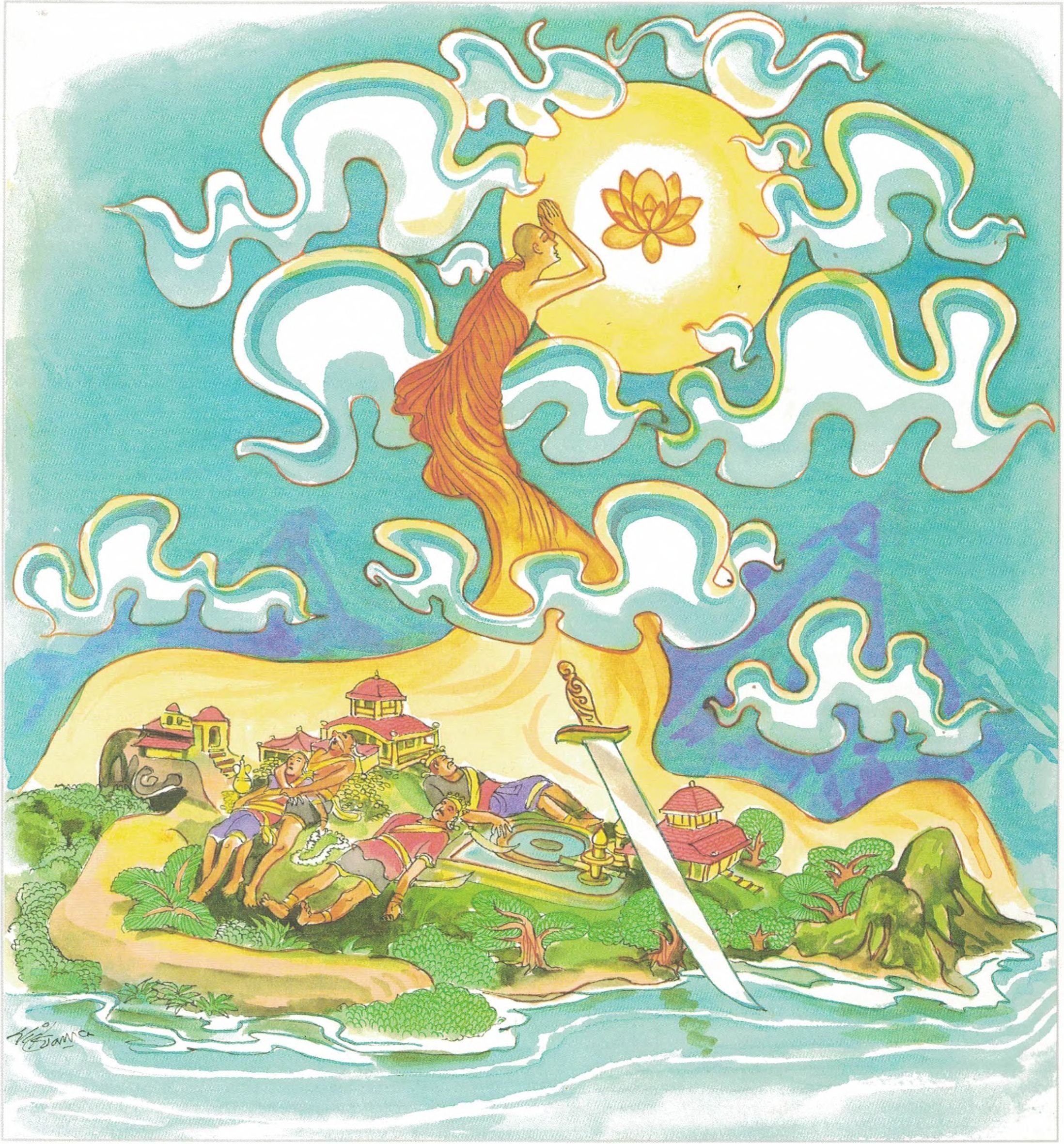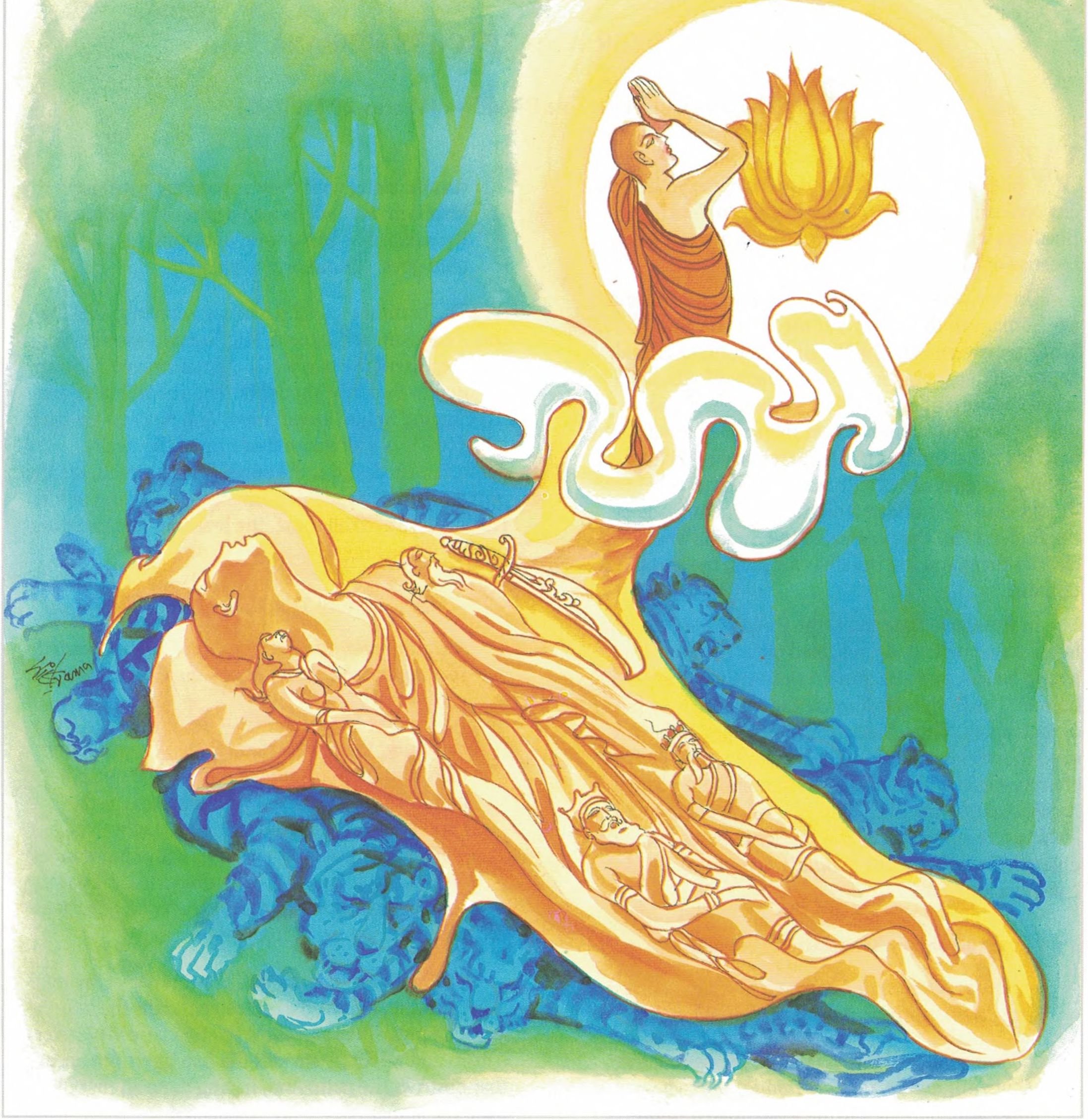Dhammapada (Illustrated)
by Ven. Weagoda Sarada Maha Thero | 1993 | 341,201 words | ISBN-10: 9810049382 | ISBN-13: 9789810049386
This page describes The Story of Venerable Bhaddiya which is verse 294-295 of the English translation of the Dhammapada which forms a part of the Sutta Pitaka of the Buddhist canon of literature. Presenting the fundamental basics of the Buddhist way of life, the Dhammapada is a collection of 423 stanzas. This verse 294-295 is part of the Pakiṇṇaka Vagga (Miscellaneous) and the moral of the story is “All failings destroyed, vision put right, and senses truly controlled, he’s the wholly perfect man” (first part only).
Verse 294-295 - The Story of Venerable Bhaddiya
Pali text, illustration and English translation of Dhammapada verse 294-295:
mātaraṃ pitaraṃ hantvā rājāno dve ca khattiye |
raṭṭhaṃ sānuvaraṃ hantvā anīgho yāti brāhmaṇo || 294 ||
mātaraṃ pitaraṃ hantvā rājāno dve ca sottiye |
veyyagghapañcamaṃ hantvā anīgho yāti brāhmaṇo || 295 ||
294. One’s mother and father having slain and then two warrior kings, a realm as well its treasurer, one goes immune, a Brahmin True.
295. One’s mother and father having slain and then two learned kings, as well the fifth, a tiger fierce, one goes immune, a Brahmin True.
 All failings destroyed, vision put right, and senses truly controlled, he’s the wholly perfect man. |
 Ridding mind-hindrances with scepticism as the fifth… he’s the thoroughly perfect man. |
The Story of Venerable Bhaddiya
While residing at the Jetavana Monastery, the Buddha spoke these verses with reference to Venerable Bhaddiya, who was also known as Lakuṇṭaka Bhaddiya because of his short stature.
On one occasion, some monks came to visit and pay homage to the Buddha at the Jetavana Monastery. While they were with the Buddha, Lakuṇṭaka Bhaddiya happened to pass by not far from them. The Buddha called their attention to the short monk and said to them, “Venerables, look at that monk. He has killed both his father and his mother, and, having killed his parents, he goes about without any dukkha.” The monks could not understand the statement made by the Buddha. So, they entreated the Buddha to make it clear to them and the Buddha explained the meaning to them.
In the above statement, the Buddha was referring to an arahat, who had eradicated craving, conceit, wrong beliefs, and attachment to sense bases and sense objects. The Buddha had made the statement by means of metaphors. Thus, the terms mother and father are used to indicate craving and conceit respectively. The eternity-belief (sassatadiṭṭhi and annihilation-belief (ucchedadiṭṭhi) are likened to two kings, attachment is liked to a revenue officer and the sense bases and sense objects (the ajjhatta and bahiddha āyatanas) are likened to a kingdom.
Explanatory Translation (Verse 294)
mātaraṃ pitaraṃ dve ca khattiye rājāno hantvā
sānucaraṃ raṭṭhaṃ hantvā brāhmano anīgho yāti
mātaraṃ [mātara]: the mother (craving); pitaraṃ [pitara]: father (egotism); dve ca khattiye rājāno [rājāna]: the two warrior kings also; hantvā: having assassinated; sānucaraṃ [sānucara]: along with their subordinate; raṭṭhaṃ [raṭṭha]: the kingdom; hantvā: having destroyed; brāhmano [brāhmana]: the saint (who has got rid of blemishes); anīgho yāti: goes without any trepidation
The brāhmin kills the mother–craving; kills the father–egotism, self-esteem;kills the two warrior kings. They represent the two views of eternalism and Nihilism–opposed to Buddhist thought. The subordinates are the clinging to life–nandi rāga. And he destroys that kingdom. It is a kingdom made up of the twelve āyatanas. He destroys the subordinates, which are the nandi rāgas. They are defilements which cling to life. Having destroyed all these, the brāhmin (arahat) goes without punishment.
Explanatory Translation (Verse 295)
mātaraṃ pitaraṃ dve ca sotthiye rājāno hantvā
veyyagghapañcamaṃ hantvā brāhmano anīgho yāti
mātaraṃ [mātara]: the mother (craving); pitaraṃ [pitara]: father (egotism); dve ca sotthiye rājāno [rājāna]: the two brahamin kings (eternalism and nihilism) also; hantvā: having assassinated; veyyagghapañcamaṃ [veyyagghapañcama]: the five fierce tigers (five hindrances); hantvā: having destroyed; brāhmano [brāhmana]: the saint (who has got rid of blemishes); anīgho yāti: goes without any trepidation
The brāhmin (arahat) kills the mother–craving; kills the father–egotism, self-esteem; kills the two learned kings. They represent the two false views eternalism and nihilism. He kills the five tigers (nīvaranas) that obstruct the path. And, having done all these killings, the arahat goes about unaffected.
Commentary and exegetical material (Verse 294-295)
These two verses indicate the variety of wrong views that have to be destroyed by a seeker who is bent on achieving the highest fruits of spiritual life.
These views come within the category of diṭṭhi. The word means view, belief, speculative opinion, insight.
If not qualified by sammā (right), it mostly refers to wrong and evil view or opinion, and only in a few instances to right view, understanding or insight (e.g. diṭṭhi-ppatta, diṭṭhi visuddhi, purification of insight; diṭṭhi-sampanna, possessed of insight).
Wrong or evil views (diṭṭhi or micchā-diṭṭhi) are declared as utterly rejectable for being a source of wrong and evil aspirations and conduct, and liable at times to lead man to the deepest abysses of depravity.
So stated the Buddha said: No other thing than evil views do I know, O’ monks whereby to such an extent the unwholesome things not yet arisen arise, and the unwholesome things already arisen are brought to growth and fullness. No other thing than evil views do I know, whereby to such an extent the wholesome things not yet arisen are hindered in their arising, and the wholesome things already arisen disappear. No other thing than evil views do I know, whereby to such an extent human being at the dissolution of the body, at death are passing to a way of suffering, into a world of woe, into hell. Whatever a man filled with evil views performs or undertakes, or whatever he possesses of will, aspiration, longing and tendencies, all these things lead him to an undesirable, unpleasant and disagreeable state, to woe and suffering.
From the Abhidhamma it may be inferred that evil views, whenever they arise, are associated with greed.
Numerous speculative opinions and theories, which at all times have influenced and still are influencing mankind, are quoted in the Sutta texts. Amongst them, however, the wrong view which everywhere, and at all times, has most misled and deluded mankind is the personalitybelief, the ego-illusion. This personality-belief (sakkāya-diṭṭhi), or ego-illusion (atta-diṭṭhi), is of two kinds: eternity-belief and annihilation-belief.
Eternity-belief (sassata-diṭṭhi) is the belief in the existence of a persisting ego-entity, soul or personality as being, more or less, identical with those physical and mental processes, and which therefore, at the dissolution at death, will come to be annihilated.
Now, the Buddha neither teaches a personality which will continue after death, nor does he teach a personality which will be annihilated at death, but he shows us that personality, ego, individual, and so on are nothing but mere conventional designations (vohāra-vacana) and that in the ultimate sense (pamattha-sacca) there is only this self-consuming process of physical and mental phenomena which continually arise and again disappear immediately.
The Buddha is free from any theory (diṭṭhigata), for the Buddha has seen what corporeality is, and how it arises and passes away. He has seen what feeling… perception… mental formations… consciousness are, and how they arise and pass away. Therefore I say that the Buddha has won complete deliverance through the extinction, fading away, disappearance, rejection and casting out of all imaginings and conjectures, of all inclination to the vain-glory based on ego.
The rejection of speculative views and theories is a prominent feature in a chapter of the Sutta-Nipāta, the Aṭṭhaka-vagga.
The so-called evil views with fixed destiny (niyata-micchādiṭṭhi) constituting the last of the ten unwholesome courses of action (kammapatha,) are the following three:
(1) the fatalistic view of the uncausedness of existence (ahetukadiṭṭhi). This was taught by Makkhali-Gosāla, a contemporary of the Buddha who denied every cause for the corruptness and purity of beings, and asserted that everything is minutely predestined by fate.
(2) the view of the inefficacy of action (akiriya-diṭṭhi). This was taught by Pūraṇa-Kassapa, another contemporary of the Buddha, who denied every kammical effect of good and bad actions. To him who kills, steals, robs and so on, nothing bad will happen. As for generosity, self-restraint and truthfulness and so on, no reward is to be expected.
(3) Nihilism (natthika-diṭṭhi). This was taught by Ajita-Kesakaṃbali, a third contemporary of the Buddha, who asserted that any belief in good action and its reward, is a mere delusion, that after death no further life would follow, that man at death would become dissolved into the elements.
Frequently mentioned are also the ten antinomies (antagāhikā micchādiṭṭhi): finite is the world or infinite is the world… body and soul are identical or body and soul are different.
In the Brahmajāla Sutta sixty-two false views are classified and described, comprising all conceivable wrong views and speculations about man and the world.
Wrong views (diṭṭhi) are one of the proclivities (anusaya), cankers (āsava), clingings (upādāna), one of the three modes of perversions (vipallāsa). Unwholesome consciousness (akusala citta) rooted in greed, may be either with or without wrong views (diṭṭhigata-sampayutta or vippayutta).
